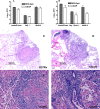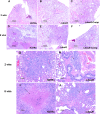Role of the dosR-dosS two-component regulatory system in Mycobacterium tuberculosis virulence in three animal models
- PMID: 19103767
- PMCID: PMC2643651
- DOI: 10.1128/IAI.01117-08
Role of the dosR-dosS two-component regulatory system in Mycobacterium tuberculosis virulence in three animal models
Abstract
The Mycobacterium tuberculosis dosR gene (Rv3133c) is part of an operon, Rv3134c-Rv3132c, and encodes a response regulator that has been shown to be upregulated by hypoxia and other in vitro stress conditions and may be important for bacterial survival within granulomatous lesions found in tuberculosis. DosR is activated in response to hypoxia and nitric oxide by DosS (Rv3132c) or DosT (Rv2027c). We compared the virulence levels of an M. tuberculosis dosR-dosS deletion mutant (DeltadosR-dosS [DeltadosR-S]), a dosR-complemented strain, and wild-type H37Rv in rabbits, guinea pigs, and mice infected by the aerosol route and in a mouse hollow-fiber model that may mimic in vivo granulomatous conditions. In the mouse and the guinea pig models, the DeltadosR-S mutant exhibited a growth defect. In the rabbit, the DeltadosR-S mutant did not replicate more than the wild type. In the hollow-fiber model, the mutant phenotype was not different from that of the wild-type strain. Our analyses reveal that the dosR and dosS genes are required for full virulence and that there may be differences in the patterns of attenuation of this mutant between the animal models studied.
Figures





References
-
- Abdul-Majid, K.-B., L. Ly, P. Converse, D. Geiman, D. McMurray, and W. Bishai. 2008. Altered cellular infiltration and cytokine levels during early Mycobacterium tuberculosis sigC mutant infection are associated with late-stage disease attenuation and milder immunopathology in mice. BMC Microbiol. 8151. - PMC - PubMed
-
- Aly, S., K. Wagner, C. Keller, S. Malm, A. Malzan, S. Brandau, F. C. Bange, and S. Ehlers. 2006. Oxygen status of lung granulomas in Mycobacterium tuberculosis-infected mice. J. Pathol. 210298-305. - PubMed
-
- Boshoff, H. I. M., and C. E. Barry. 2005. Tuberculosis metabolism and respiration in the absence of growth. Nat. Rev. Microbiol. 370-80. - PubMed
Publication types
MeSH terms
Substances
Grants and funding
LinkOut - more resources
Full Text Sources
Other Literature Sources
Medical

